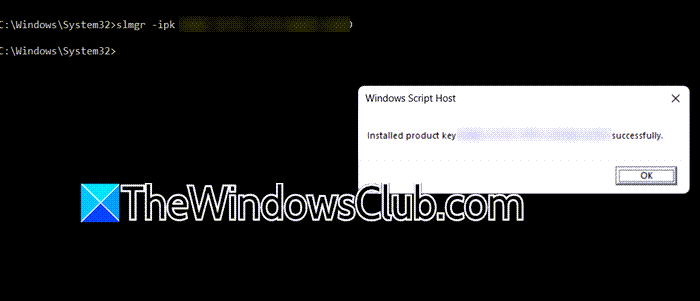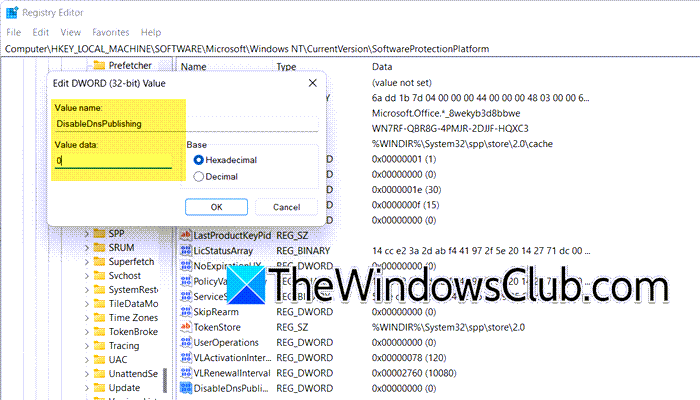You might experience DNS-related Activation issues when activating a client machine because the activation wizard relies on DNS to find the computer running the KMS software. If the wizard queries DNS and cannot locate the DNS entry for the KMS host computer, it will display an error message. This post will discuss things you can do to resolve them.
Fix DNS-related activation issues on Windows Server
If you encounter any DNS-related activation issues on Windows Server or Windows 11, follow the solutions mentioned below to resolve the issue.
- Check the DNS configuration
- Change the product key to an MAK
- Install Volume Activation Service
- Assign a KMS host to the client manually
- Create DisableDnsPublishing value
Let us discuss them in detail.
1] Check the DNS configuration

If we face any DNS-related activation issue on Windows, we should first check the configuration and ensure everything is all right. To do so, open the Command Prompt and run the following command.
ipconfig /all
We need to check a few things. First, check the allocated IP address of the client device. Then, check the KMS client’s primary DNS and default gateway’s IP. Finally, check the DNS suffix search list of the same.
Now, we need to check if the KMS hosts SRV records are registered in DNS. To do that, open the Command Prompt as an administrator and run the following command.
nslookup -type=all _vlmcs._tcp>kms.txt
This command will generate a text file called kms.txt. Open it, and you will find a line of codes similar to the one mentioned below.
_vlmcs._tcp.contoso.com SRV service location:
priority = 0
weight = 0
port = 1688 svr hostname = kms-server.domain.com
Here, domain.com will be different in your case as it represents your actual domain name.
You need to check the IP address, hostname, port, and domain name and make sure that _vlmcs entries exist. If you see redundant KMS host names, go to the fourth solution to see how to manually assign a KMS host.
If nslookup finds the KMS host, it doesn’t guarantee the DNS client can. If you can’t activate it after finding it, check your primary DNS suffix and the DNS suffix search list.
2] Change the product key to an MAK

If you can’t install a KMS host or use KMS activation, switch the product key to a Multiple Activation Key (MAK). If you got Windows images from the Microsoft Developer Network (MSDN) or TechNet, the stock-keeping units (SKUs) listed are usually volume-licensed. The product key that comes with this media is typically an MAK key. To do so, open the Command Prompt as an administrator, and then run the following command.
slmgr -ipk <product-key>
Replace the <product-key> with your actual product key; you can get that by running the command – wmic path SoftwareLicensingService get OA3xOriginalProductKey.
You will get a prompt saying Installed product key <product-key> successful signaling that your product is activated.
3] Install Volume Activation Service

KMS activation requires a configured KMS host for clients. Install and activate one using a KMS host key if none are set up. After configuring the host, remember to publish the DNS settings. To do this, we need to have Volume Activation Services on the client device. To do so, follow the steps mentioned.
- Open the Server Manager.
- Click on Add roles and features.
- Keep clicking on Next until you reach the Server Roles tab.
- Tick Volume Activation Services and click on Next.
- If a feature is required, you will get a prompt to install it as well.
After installing the feature, you must configure the KMS host to see if that helps.
4] Assign a KMS host to the client manually
KMS clients use an automatic discovery process by querying DNS for a list of KMS hosts with published SRV records. The DNS returns the list in a random order. The client selects a host and tries to establish a session. If successful, the client caches the host’s name for future use; if not, it selects another host randomly. However, when we encounter an issue at times, we recommend you manually assign the KMS host to the client. To do so, open the Command Prompt on the client device and run one of the following commands.
Run the following command to assign a KMS host by using the FQDN.
cscript \windows\system32\slmgr.vbs -skms <KMS_FQDN>:<port>
Run the following command to assign a KMS host by using the IPv4 IP address.
cscript \windows\system32\slmgr.vbs -skms <IPv4Address>:<port>
Run the following command to assign a KMS host by using the IPv6 IP address.
cscript \windows\system32\slmgr.vbs -skms <IPv6Address>:<port>
Run the following command to assign a KMS host by using the NETBIOS name of the host.
cscript \windows\system32\slmgr.vbs -skms <NETBIOSName>:<port>
If you want to turn back the automatic discovery, you can execute – cscript \windows\system32\slmgr.vbs -ckms.
Read: Fix 0xc004f069 Windows Server Activation Error
5] Create DisableDnsPublishing value

Next, we need to ensure that the KMS host server is registering with the DNS. To do that, we need to see if DisableDnsPublishing is enabled. If not, we will make the required changes. Before making any changes to the registry, we recommend that you take a backup of all your registries. Once done, follow the steps mentioned below.
- Open the Registry Editor.
- Navigate to
Computer\HKEY_LOCAL_MACHINE\SOFTWARE\Microsoft\Windows NT\CurrentVersion\SoftwareProtectionPlatform. - Look for DisableDnsPublishing. If it’s not there, create a DWORD value. Then, the value should be set to 0 or undefined (the default), which means that the KMS host server registers an SRV record once every 24 hours. If it’s 1, it should not automatically register SRV records.
After making the changes, reboot the machine and see if the issue is resolved.
Hopefully, you can resolve the issue using the solutions mentioned in this post.
Read: How to resolve DNS issue on Windows 11
How to troubleshoot DNS issues on Windows server?
You may encounter various DNS issues on the server. However, we first need to check the DNS configuration. You can run the ipconfig /all command to check the port and IP address and make sure that there are no false configurations. Also, there are a lot of KMS hosts and client issues that may come your way. To resolve them, we recommend following the solutions mentioned in this post.
Read: Your DNS Server might be unavailable in Windows 11
How do I fix Windows DNS server isn’t responding?
You can do various things if the DNS server isn’t responding. You can configure the DNS manually, and use a different DNS address, maybe switch to Google Public DNS and see if that helps. Also, we recommend you follow the solutions mentioned in our guide to perform when the DNS server is not responding.
Read next: Active Directory Users and Computers not responding.